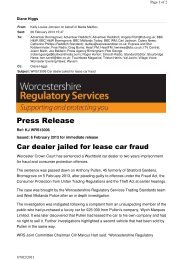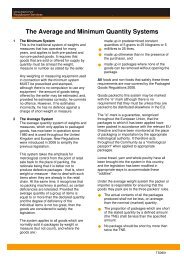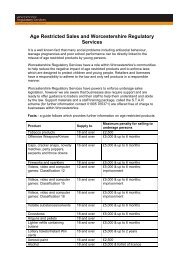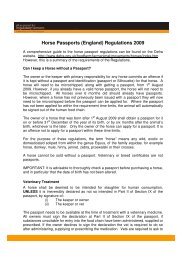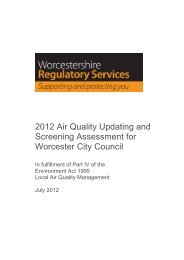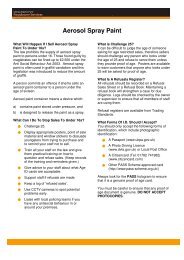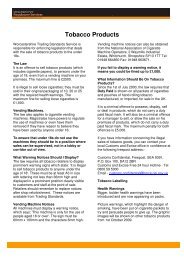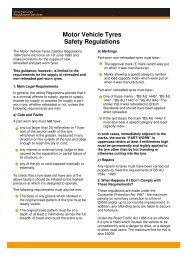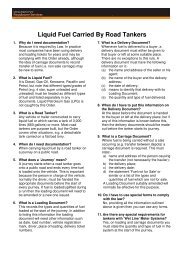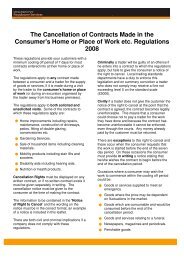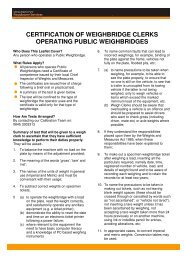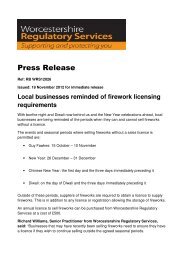Selling second hand goods? - Worcestershire Regulatory Services
Selling second hand goods? - Worcestershire Regulatory Services
Selling second hand goods? - Worcestershire Regulatory Services
Create successful ePaper yourself
Turn your PDF publications into a flip-book with our unique Google optimized e-Paper software.
Pointing out a faultIf someone returns an item because of a fault and itwas pointed out at the time of sale, or a fault that wasclearly evident on reasonable examination, they arenot entitled to a refund.But if they return something for a different problem,they have the same rights as if the item were soldas perfect. For example, if you sell a television witha scratch on the screen which is pointed out to thecustomer, or which should have been easily noticed,they cannot expect a refund because of the scratch.But if the television does not work, they have the samerights as if it were not scratched.Looking after your customersTo enhance your reputation you can do more for yourcustomers than the law requires you to. For example,you can give a refund or exchange for items, whichare unwanted but you must not deny consumers theirrights.Who is responsible?When you sell something, you are making a contractwith the customer. If there is a problem with anythingyou sell, it is your responsibility to sort it out.You cannot evade your responsibilities by displaying a‘no refunds’ or ‘sold as seen’ sign. In fact, it is illegal toput up this type of sign or to have restrictive statementson notices, labels, advertisements, receipts, invoices,delivery notes etc.If the customer has a legitimate claim you can insiston proof of purchase, but this does not have to be areceipt.PricingTraders must give accurate information about the priceof <strong>goods</strong> displayed. The price of virtually all <strong>goods</strong> onsale must be shown, including items in window displaysand other types of display. The price should be shownin one of the following ways and must include VAT:l On a price ticket on each iteml On a nearby shelf edge ticketl On a nearby price listAdvertisements and other postersYou do not have to state prices in advertisements orposters. However, if you do show a price, it must beclearly readable.Sale ItemsWhen your shop has a sale, ensure that all pricecomparisons in relation to the previous higher price areclear and meaningful. The easiest way to do this is havea label with ‘Was £6 – Now £4’.If there is a rail of clothes or shelf of books etc., all ofthe same price, eg. ‘All books on this shelf 50p’, makesure there are not higher priced books in that area.If there is a sale and there is an advertisement stating‘Sale from 50% off’, a significant amount of the <strong>goods</strong>should be half price, a good rule is around 10%.If there is a sale and there is an advertisement stating‘Sale everything £1 and under’, make sure that there areno higher priced <strong>goods</strong> on sale.Remember: Prices must be clear and legible and itmust be obvious which item(s) a price relates to.The following are types of statement which you shouldnot use.l ‘no cash refunds’l ‘no sale <strong>goods</strong> exchanged or money refunded’l ‘sold as seen and inspected’l ‘no refunds or exchanges without a receipt’Remember: These are not to be used even if youinclude the statement ‘your statutory rights are notaffected’.
How can I describe my <strong>goods</strong>?Most <strong>goods</strong> are sold with a description of some sort.Where you give a description in the course of business, itmust be accurate and not misleading.What is a description?Descriptions can relate to most characteristics of <strong>goods</strong>,including:l Age or historyl Quantity or sizel Fitness for purposel Method and place of manufacturel Compositionl Any form of approval or recommendationA description can be given verbally, in writing,in advertisements, by illustration or by implication.Displaying your business nameYou are required by the Business Names Act 1985 toinform people about the ownership of your business.You must prominently display the names and addressesof the owners of your business on your premises, usuallyon a separate notice and with an address in Great Britain,where service of documents about the business will beeffective.This is necessary so that it can be read easily in all placeswhere you carry on your business, and where you dealwith customers or suppliers.The information must also be shown clearly on:l All business lettersl Written orders for the supply of <strong>goods</strong> or servicesl Invoices and receipts (including till rolls)l Written demands for the payment of business debtsIf anyone you are doing business with asks for yourbusiness ownership details, you must tell them in writingimmediately.Registered CompaniesThe Companies Act 1985 and 1989 require that a registeredcompany must show the name of the company outsideall of its premises. The registered office and companyregistration number must also be given on all businessletters and orders.



